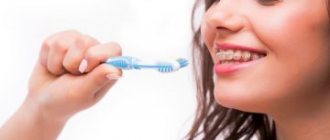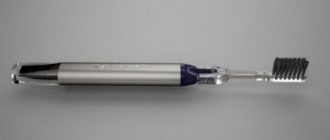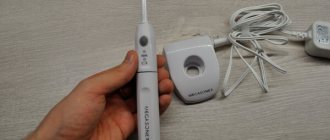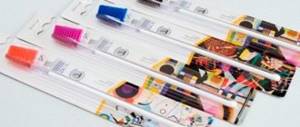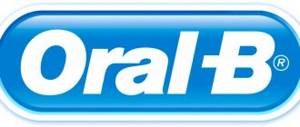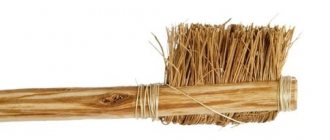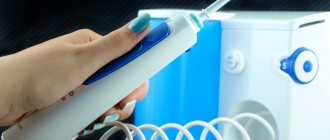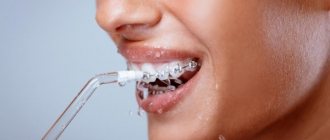The quality of oral care determines the health of teeth, their protection from the influence of cariogenic microbes, the absence of an unpleasant odor, as well as the whiteness and beauty of a smile. To keep your mouth clean, you need a reliable companion – a toothbrush. The characteristics it has determine how atraumatically and efficiently the enamel will be cleaned. What takes better care of your teeth: a soft toothbrush or a hard one? How to choose the right dental assistant? Let's take a closer look at these issues.
Distinctive features of a soft toothbrush
Keep in mind! If you are an adult with dental problems: a soft toothbrush is what you need.
The plastic bristle gently cleanses the enamel without causing discomfort or provoking inflammatory complications.
However, such bristles cannot penetrate the narrow interdental spaces .
The product marked soft or medium has a stiffer bristle and is suitable for people with a healthy oral cavity.
In any case, you can use dental floss to clean hard-to-reach areas .
Indications for using a soft bristle brush
This hygiene item is not suitable for everyone, and in some cases it does not fully do its job.
It is worth noting! Soft dental appliances are ideal for:
- babies learning to care for their first teeth;
- children during the period of replacement of milk teeth with permanent ones (10-12 years);
- people with poor blood clotting (diabetics);
- adults with sensitive, easily damaged enamel ;
- people with various oral diseases (periodontitis, gingivitis, stomatitis, periodontal disease);
- patients with tooth mobility syndrome.
Also, a soft toothbrush is ideal for adults with a history of erosive lesions or wedge-shaped defect .
Dentists recommend buying soft toothbrushes for children under 10 years of age.
This is due to the imperfection of dental tissues and the vulnerability of the mucous membrane.
Hard fibers can cause damage, leading to more serious consequences.
For older people, a soft-bristle toothbrush is ideal..
Know! Over time, the body wears out, and this directly affects the gums: they become loose and bleed at the slightest damage.
How to make a brush softer
I was skeptical about this option. It’s one thing to add extract to women’s hand creams. It’s quite another to soften a stiff and dry toothbrush. Well, okay, let's try.
Aloe Vera Gel
Tips from the Internet say:
- pour some aloe gel into a glass;
- lower the brush there;
- leave for 5-10 minutes.
It took me about 10 minutes to make sure that the humidifier was working. After this, you need to rinse the bristles under water. I haven’t tried the options with soda and salt.
Common sense dictates that modern brushes can only deteriorate from such chemical experiments.
As for salt and soda, it is better not to use them
Comparing the “cheap and cheerful” options with water and “expert advice” about aloe, I will say that I did not find any huge difference. In both cases, the bristles have become softer and brushes teeth normally. If you have gum disease, don't even try using hard brushes. This is quite capable of causing exacerbations and even tooth loss.
Every self-respecting person takes care of oral hygiene. His health, personal life, and career depend on it.
Fresh breath encourages your interlocutor to communicate, so it is necessary to use oral cleaning products. The most common personal hygiene item is a brush.
People have been using it almost since infancy. Not all adults know how to choose it, how to care for it and how often to change it.
If you approach this issue carelessly, there is a risk of ruining not only the enamel of your teeth, but also your gums. You can lead the situation to chronic diseases, which are impossible to get rid of. How to approach the purchase, what nuances to pay special attention to? How to make a brush very soft and what are the options for the development of events?
How to determine hardness by marking?
For the convenience of the consumer, the manufacturer labels its product in a certain way.
To choose a product with soft pile, it is not necessary to determine its hardness to the touch.
Guided by labeling , and not appearance, dental care item
- Sensitive . A device with this marking is equipped with very soft bristles . It gently removes plaque without damaging tooth enamel. Suitable for young children or adults suffering from periodontal disease. A soft brush is also good for cleaning sensitive teeth. However, you should consult your dentist before use.
- Soft . This product is suitable for elderly people and diabetics. They are also recommended for use by patients with oral diseases and pregnant women with gingivitis. It is important to use the instrument using a special technique that eliminates pressure on weakened tissues.
- Medium. This marking indicates medium-hard bristles . Well suited for people with healthy teeth.
- Hard. Model with stiff bristles : good for experienced smokers and coffee lovers. It is effective in removing dark stains on teeth, but is not suitable for daily use. If your teeth are sensitive, it is strictly forbidden to use it.
- Extra-hard. Products with similar markings are designed for cleaning dentures , bridges and braces. Such hard bristles can cause irreparable harm to living teeth.
Stay up to date! Knowing the meaning of each marking when choosing a brush that is suitable for your teeth will not be difficult and will save time.
Pay attention to stubble
Toothbrushes are classified according to the following criteria:
- type of bristles;
- number of lines with bristles;
- rigidity;
- size of the working surface;
- The main purpose;
- type of bristle trimming.
A very important point is the choice of fiber from which the brush is made! Do not strive for natural materials, as they cannot guarantee proper hygiene and are capable of rapid proliferation of pathogenic microorganisms. In addition, the bristles on such a brush are very soft, but its small tips have a sharp edge and easily injure not only soft tissues, but also the enamel on the teeth.
Artificial material has better physical and mechanical characteristics. For example, nylon fibers are flexible, resistant to kinks, can be easily sanded and have a longer service life.
Dentists advise patients with normal oral health to use toothbrushes with soft bristles or medium hardness; hard special ones are suitable for those who have strong teeth and excellent periodontal disease.
When buying a toothbrush with the hardness of certain parameters, you should know that a very soft one (ultrasoft, extrasoft) is necessary for the first teeth of babies and for children up to 5 years of age. Soft hardness (soft) – for children under twelve years of age or for sensitive teeth prone to bleeding. Toothbrushes for children over twelve years of age and adults can be selected with medium hardness.
As for the size of the toothbrush, it is better to take one with a small working surface that can grip two teeth located next to each other. Thus, the length of the brush in toothbrushes for children should be 1.8 -2.5 cm, and for adults - about 3 cm.
With such a toothbrush, brushing your teeth will be much more effective; it is convenient for it to carry out any manipulations, and, accordingly, to clean the most inaccessible corners of the oral cavity.
Kinds
Today there are several types of brushes for delicate dental care.
Each type has its own advantages and disadvantages . In any case, the choice remains with the consumer.
Regular
The length and shape of the ends of the pile and the number of tufts are an important selection point.
Sharp bristles are suitable for removing plaque in hard-to-reach places , but people with fragile enamel and weakened gums should not buy them.
Dental appliances labeled soft or sensitive are the right choice in this case. Their soft bristles are rounded and avoid scratching.
Note! For daily dental care, it is better to choose a soft brush with frequent bristles.
Combined
These dental instruments are available both conventional and electric. Their heads are equipped with soft bristles on one side and hard (elongated) bristles on the other.
Products of this kind are quite
effective and at the same time practically safe.
Electrical
They have an original design and are multifunctional .
Under the influence of current, the head of this model rotates intensively, which allows you to effectively remove plaque without driving it under the gum .
However, electric toothbrushes can damage sensitive enamel and gum tissue . To prevent this from happening, the kit comes with a nozzle with soft bristles.
When the heads wear out, you can replace them with new ones.
Ultrasonic
Know! These toothbrushes are similar in appearance to electric ones. They are a new word in technology and have not yet become widespread.
The impact occurs due to low-frequency wave vibrations, which effectively remove the oldest plaque.
Ultrasonic attachments
are strictly contraindicated for: pregnant women , people with neoplasms in the oral cavity, persons with impaired keratinization of the mucous epithelium .
Ionic
Brushes of this kind have appeared quite recently. The operating principle is based on the rotation of a rod coated with titanium dioxide molecules.
When it reacts with liquid (saliva), the substance attracts hydrogen ions . are the ones who kill pathogenic bacteria and eliminate the acidic environment.
An ionic toothbrush allows you to save on the purchase of toothpaste.
Important to remember! It is contraindicated for smokers: nicotine, which reacts with hydrogen ions, has a destructive effect on the mucous membrane.
For cancer patients, as well as people with oral fluid deficiency syndrome, the use of this brush is not recommended.
How to make it soft at home?
If you accidentally purchased a hard toothbrush that doesn’t suit you and causes a lot of discomfort, you can soften it in several ways:
- Through hot water. To do this, you need to hold it under running water at 40-50˚C or soak it in a glass. Steep boiling water is not suitable for this purpose, as the synthetic bristles may melt and the brush will become unusable.
- Hydrogen peroxide. This method is the fastest and most effective. To do this, you need to put the toothbrush in a glass with a 3% peroxide solution so that it covers the head with the bristles. After 5 minutes, you can take it out and rinse it with running water and safely use it.
- Aloe Vera gel. This product effectively softens the skin and can be used with a toothbrush for the same purpose. The method of application does not differ from the version with hydrogen peroxide, however, it should be kept in the gel for at least 10 minutes.
- Tooth rinse. These hygiene products have antibacterial properties and will also help soften the hard bristles of your toothbrush. The components contained in the rinse aid can restore old, dried out fibers. To do this, you need to fill the glass halfway with the product, lower the toothbrush into it and wait the required amount of time. The hardest pile becomes soft in half an hour.
Mouthwash
Take a clean glass and fill it with mouthwash. There is no need to fill to the top. The main thing is that when you lower the brush there, the bristles are completely hidden. You can even soak old brushes that you haven’t thought about for a long time and that have already dried out in this way.
Mouthwash
Personally, I tried this method on myself. I had a couple of brushes lying around at home that I took out of boxes and forgot. They weren't used, so I didn't throw them away. I took about 100 ml of liquid, poured it into a cup, and left the brush in it until the morning. Honestly - just like in advertising - soft and comfortable.
Using mouthwash
Review of the most popular models
You should know! There are many high-quality toothbrushes on the modern consumer market.
Here are the most popular models equipped with soft bristles:
- Exceed by Oral-B. Polyamide bristles are arranged in a special way, which allows them to penetrate into the most difficult to reach places. On the back of the head there is a special surface for cleansing the mucous membranes of the cheeks and tongue. The handle has rubberized inserts for ease of use.
- SPLAT Professional Sensitive. The bristles on this brush model have rounded ends and are divided into 4 parts. This eliminates injury to weakened gums and sensitive tooth surfaces. Each fiber is treated with silver ions, which has a disinfecting effect. This brush delicately removes plaque without scratching the cavity tissues.
- LACALUT Sensitive. The pile of this model is made of nylon threads impregnated with silver ions. The rounded bristles do not scratch the enamel and do not injure the gums. This brush is ideal for young children and people with sensitive teeth.
- Colgate 360 SensitivePro–Relieve. This model is equipped with the finest bristles, between which there are rubber cups. This allows you to gently clean and polish your tooth enamel. The elongated bristles penetrate into the interdental spaces and remove the smallest particles of food. On the back of the head there is a soft brush for cleaning the tongue, which reduces the growth of pathogenic microorganisms in the mouth.
- Jordan Target Sensitive. The thickness of the bristles of this model is only 0.01 mm, which allows them to effectively clean even the back surface of the teeth. The brush is good for people with various oral diseases and those who wear braces. The compact and ergonomic handle is comfortable to hold during use.
- Silka Favorite. It is distinguished by its versatility due to the originality of its design. Two-level nylon bristles allow for thorough cleaning of the gingival groove, gently massaging the gums, and the beveled lower fibers carefully remove plaque. There is a special ledge for hard-to-reach areas. The handle has a thumb ridge.
Remember! If you suffer from oral diseases and want to purchase a special toothbrush: be sure to consult your dentist.
Electrical Products
Electrical products used for oral hygiene have recently been in great demand; an increasing number of people are trying to acquire “vibrating leaders” for themselves. But in fact, their popularity is not particularly supported by anything. They remove plaque from the surface of the teeth a little better than the manual ones we are used to, but there is a risk of damage to the fillings, crowns and other prostheses present in the mouth; over time, they become loose. In addition, massage of the gums with a mechanical toothbrush must be done not while it is vibrating, but in the off state, which can be done with a regular brush.
All hygienic electrical appliances are divided into:
- classic options that are equipped with a rotating element;
- sound, they are characterized by their oscillatory effect when cleaning the surface of the teeth;
- ultrasonic models that produce strong vibrations.
